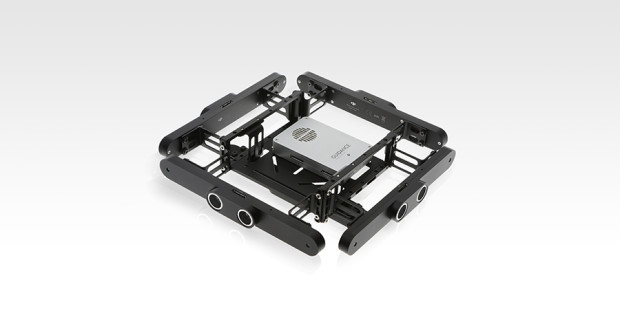
Today, DJI announced a new modular quadcopter platform called the Matrice 100. The drone is due out later this month and is DJI’s most customizable product yet in terms of both hardware and software.
With a base price of $3,299, the Matrice 100 is far from the entry-level DIY drone you might be hoping for. Instead, DJI is pitching the Matrice as a one-stop drone kit for corporate and academic research and development.
Matrice 100
The Matrice 100 quadcopter measures around 26″ wide diagonally — only slightly larger than their Phantom 3 drone. The unassembled kit is bundled with everything you need to fly, including a remote control, battery, an N1 flight controller system, and a unique Pro Plus GPS compass that allows for precise tracking.
The lightweight frame is designed with customization in mind, with slots and holes for mounting additional hardware. A secondary battery expansion bay is included in the design, which if taken advantage of, extends the maximum flight time of the drone from 20 minutes to 40 minutes.

A range of additional ports are offered on the Matrice, including two parallel CAN ports that support DJI’s line of accessories, dual parallel UART ports for third-party connectivity, and power connections for two types of common standards (XT60, EC3).
It’s worth noting that there are no cameras included with the Matrice 100. Instead, users are expected to use their own cameras or separately purchase a camera and gimbal system from DJI.
Guidance
Of all the accessories available for the Matrice 100, the one most likely to be added to a drone developer’s shopping cart is DJI’s visual sensing system, Guidance.

With an open SDK and a suite of ultrasonic sensors and cameras, DJI’s $999 Guidance add-on gives the Matrice 100 a method for centimeter-accurate visual positioning, even without the aid of GPS. It also provides the Matrice 100 with a robust obstacle detection and avoidance system which is essential for autonomous flight.
A New Drone for New Markets
Over a relatively short time DJI has become a premier brand for consumer drones, with products such as the Inspire 1 and their Phantom line. But with the market quickly evolving and expanding to include unique professional and industrial uses, DJI’s traditionally closed systems limited their utility for development.
With the Matrice 100 and a new attitude towards opening up the SDKs for their flagship consumer drones, the Inspire 1 and Phantom line, DJI is clearly looking to expand its appeal beyond hobbyists.
If we are truly heading toward a future of drone-enabled services — security, delivery, parking enforcement, agricultural monitoring, and more — DJI is smart to position themselves as an ally in creating the custom hardware these niche corporate customers require.
ADVERTISEMENT














